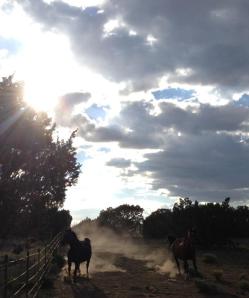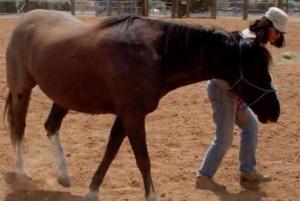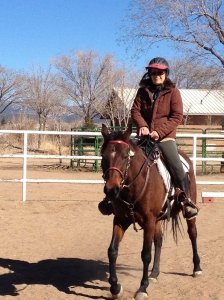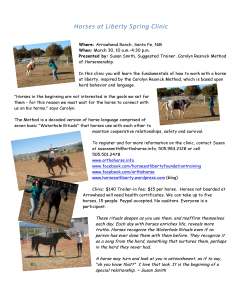Ray Hunt used to say, is it getting better with your horse, is it the same, or is it getting worse? If it is getting worse or remaining the same without any improvement, it’s time for a change or maybe to do some things the same but add in a little something else.
Within the Waterhole Rituals created by Carolyn Resnick, there are plateaus students reach where they may need guidance with their horses. The points at which this happens is when they have to send their horses away, or when they have to shift from the comfortable companionship which doesn’t demand much (in most cases) to taking territory and getting a reciprocal relationship. Even though it might be disappointing, I want people to see this as an opportunity to strengthen the bond with their horses.
 The Waterhole Rituals, or liberty work, can be very dangerous if you do not get adequate and good instruction. Horses at liberty are more dangerous than ones tied up or encased in a round pen. The reason we do liberty training is to gain a deeper relationship than we do by starting the relationship with tack. We also expose unwanted behaviors that may come out later, like in ground work or under saddle. This is why we start with sharing territory which can be done with most horses except extremely aggressive or dangerous ones. In those cases it might be advisable to have your certified and/or suggested trainer work with the horse first, and that involve sharing territory by staying outside the corral for awhile.
The Waterhole Rituals, or liberty work, can be very dangerous if you do not get adequate and good instruction. Horses at liberty are more dangerous than ones tied up or encased in a round pen. The reason we do liberty training is to gain a deeper relationship than we do by starting the relationship with tack. We also expose unwanted behaviors that may come out later, like in ground work or under saddle. This is why we start with sharing territory which can be done with most horses except extremely aggressive or dangerous ones. In those cases it might be advisable to have your certified and/or suggested trainer work with the horse first, and that involve sharing territory by staying outside the corral for awhile.
Often students really like the fuzzy feeling of being close to their horses, but they don’t like having to send their horse away. They are afraid the horse won’t like them or won’t come back. We need to have this element of freedom in the relationship, otherwise the relationship gets too sticky and doesn’t feel right. It’s like couples who spend every waking hour together. They don’t have any pizzazz and interest any more.
In all of this we also have to assess our own energy levels and make sure we aren’t falling into the relationship, and that we feel strong in our heart space and our center line, our feet planted firmly on the ground, reaching into the ground. We can extend that space out towards our horses, or bring it in, depending on what we need at the time. If we can remain conscious of this throughout our work with horses, we don’t run so much risk of losing ourselves. The blog I wrote about chakras, Chakra balancing explains how our body is divided into these segments that we can check in with to assess their various strengths and weaknesses. We can apply this knowledge to our work with our horses.
From when I first got my new mare, Jazzie, two months ago, she has companioned walk everywhere with me, including stop and go and back up. I wish I had a video of it.  She was very excited about the new relationship. She is a strong, very opinionated mare accustomed to being in charge. I knew as we became more familiar with each other, this would change. After awhile she got bossy about food and rude, which was exciting to me. She didn’t want to be haltered one day, so I sent her off. When I first sent her away she leapt up into the air and flung her head in indignation. She did this two or three times when I sent her and finally, she came over to the fence without my asking, and dipped her head into the halter nicely. It was what she needed to establish a new level of our relationship – a mutual respect. Without the send, I would not have the draw that she ultimately gave me.
She was very excited about the new relationship. She is a strong, very opinionated mare accustomed to being in charge. I knew as we became more familiar with each other, this would change. After awhile she got bossy about food and rude, which was exciting to me. She didn’t want to be haltered one day, so I sent her off. When I first sent her away she leapt up into the air and flung her head in indignation. She did this two or three times when I sent her and finally, she came over to the fence without my asking, and dipped her head into the halter nicely. It was what she needed to establish a new level of our relationship – a mutual respect. Without the send, I would not have the draw that she ultimately gave me.
If I didn’t do this I would end up with a horse who figures she doesn’t have to listen to anything I say. I want her to recognize her importance in the relationship, not as the leader over me, but recognize my leadership as I recognize hers. She made this choice on her own. I just set it up so it could happen. And of course, I realize this is not the last time I may be doing this. This desire to move me shows up in a lot of my other interactions with her.
I wouldn’t do this with a shy horse, in fact, I’d take a lot longer to get to the send away phase because that horse might not come back for a long time. So it’s important that we don’t treat all horses the same, and dump the same training techniques on each and every one. We have a template of the Rituals to get started with, but sometimes we skip some and come back to them later, depending upon the personality we’re working with.
This stage may look as though nothing is happening or not happening right to the casual observer. But I get excited about those parts because I know that change will happen because of the stage we’re in.
We have more control over the horse on the ground than we do in the saddle. When we’re on board, we have our hands, feet, seat, voice as aids. When we’re on the ground, we have hands, feet, voice, more ways of moving our own bodies and eye contact. Eye contact is extremely important and part of why we start with the liberty work rather than with tack. The horse that doesn’t give you eye contact is far less safe than the horse that does. Eye contact is what keeps a herd alive; a horse in a herd knows where every other horse is, especially those in close proximity. Eye contact shifts just as it does when you’re driving a car – you are looking in front of you, then you check your side and rear view mirrors, always circulating your attention so that you have a largely global view. That is how the horse is. You want to be acknowledged in this global view.
The thing is, I’m not afraid of Jazzie not liking me. I know she likes me, but that doesn’t mean she won’t challenge me once in a while. She is a lead mare and used to bossing other horses around. I enter her space now as a lead mare too, so we must figure that one out. I didn’t spend too much time at the bottom of the pecking order with her, because I knew she would ultimately ignore me if I did.
All of this translates to work in the saddle or in-hand. Although Jazzie is trained under saddle, she is green in many ways. I know that if I don’t give clear cues and have her attention from the beginning, she will not see me as a worthy leader. Some horses will take matters into their own hooves if they don’t find me to be worth listening to. I could just get on and ride as I always used to do, but I feel the Waterhole Rituals give us strong building blocks and builds a great foundation in getting to know each other. What I’m looking for is to feel the deep connection between us when I climb into the saddle.
Private sessions and gift certificates are available for bodywork and liberty work, by calling 505.501.2478 or emailing susansmith@orthohorse.info
Click on this flyer to find out about my upcoming Spring Liberty Clinic to be held March 30th in Santa Fe.






GREAT article!!!!! Very helpful.
Outstanding article on leadership with the Waterhole Rituals. I’m always eager to read the ‘next exciting chapter’ about your horses!
Thanks, Ruella. The chapters are endless, as you know 🙂
Loved the story of Jazzie and sending her away, it reminds me of my Kody. I also like the line: Some horses will take matters into their own hooves if they don’t find me to be worth listening to. There came a point when Kody “took matters into his own hooves”, but with the WHR I have been able to turn that around and he now thinks that I may just be worth listening too! : )
Thanks, Ann. Sounds like the Waterhole Rituals really resonate with Kody and that you two will have great times together. I hope I get to meet him soon 🙂